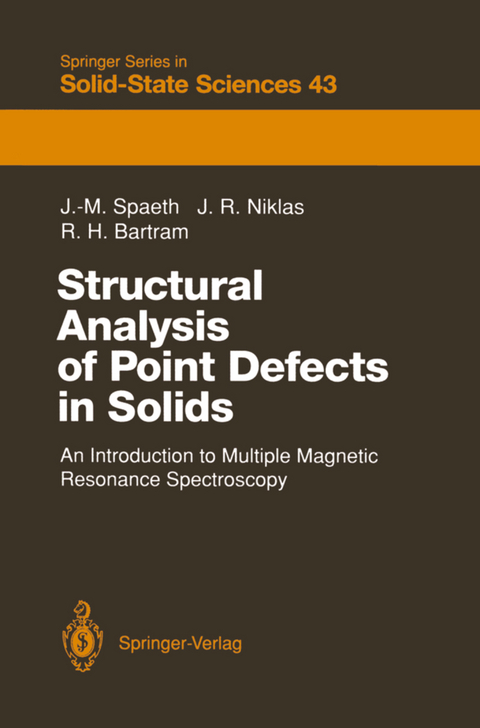
Structural Analysis of Point Defects in Solids
Springer Berlin (Verlag)
978-3-642-84407-2 (ISBN)
Structural Analysis of Point Defects in Solids provides a comprehensive introduction to the principles and techiques of modern electron paramagnetic resonance spectroscopy applied to the determination of microscopic defect structures. It informs the nonspecialist about the potential of the different methods, while the researcher faced with the task of determining defect structures will find here the necessary tools. The book will be useful for materials scientists working in semiconductor physics, laser physics, radiation damage, etc., and also for mineralogists and solid state chemists.
1. Introduction.- 1.1 Structure of Point Defects.- 1.2 Basic Concepts of Defect Structure Determination by Electron Paramagnetic Resonance.- 1.3 Superhyperfine and Electronic Structures of Defects in Solids.- 2. Fundamentals of Electron Paramagnetic Resonance.- 2.1 Magnetic Properties of Electrons and Nuclei.- 2.2 Electrons and Nuclei in an External Magnetic Field.- 2.3 Some Useful Relations for Angular Momentum Operators.- 2.4 Time Dependence of Angular Momentum Operators and Macroscopic Magnetization.- 2.5 Basic Magnetic Resonance Experiment.- 2.6 Spin-Lattice Relaxation.- 2.7 Rate Equations for a Two-Level System.- 2.8 Bloch Equations.- 2.9 Conventional Detection of Electron Paramagnetic Resonance and Its Sensitivity.- 3. Electron Paramagnetic Resonance Spectra.- 3.1 Spin Hamiltonian.- 3.2 Electron Zeeman Interaction.- 3.3 g-Factor Splitting of EPR Spectra.- 3.4 Fine-Structure Splitting of EPR Spectra.- 3.5 Hyperfine Splitting of EPR Spectra.- 3.6 Superhyperfine Splitting of EPR Spectra.- 3.7 Inhomogeneous Line Widths of EPR lines.- 4. Optical Detection of Electron Paramagnetic Resonance.- 4.1 Optical Transitions of Defects in Solids.- 4.2 Spectral Form of Optical Transitions of Defects in Solids.- 4.3 EPR Detected with Magnetic Circular Dichroism of Absorption Method.- 4.4 MCDA Excitation Spectra of ODEPR Lines (MCDA "Tagged" by EPR).- 4.5 Spatially Resolved MCDA and ODEPR Spectra.- 4.6 Measurement of Spin-Lattice Relaxation Time T1 with MCDA Method 105.- 4.7 Determination of Spin State with MCDA Method.- 4.8 EPR of Ground and Excited States Detected with Optical Pumping.- 4.9 EPR Optically Detected in Donor-Acceptor Pair Recombination Luminescence.- 4.10 Optically Detected EPR of Triplet States.- 4.11 ODEPR of Trapped Excitons with MCDA Method.- 4.12Sensitivity of ODEPR Measurements.- 5. Electron Nuclear Double Resonance.- 5.1 The Resolution Problem, a Simple Model.- 5.2 Type of Information from EPR and NMR Spectra.- 5.3 Indirect Detection of NMR, Double Resonance.- 5.4 Examples of ENDOR Spectra.- 5.5 Relations Between EPR and ENDOR Spectra, ENDOR-Induced EPR.- 5.6 Electron Nuclear Nuclear Triple Resonance (Double ENDOR).- 5.7 Temperature Dependence and Photo-Excitation of ENDOR Spectra.- 6. Determination of Defect Symmetries from ENDOR Angular Dependences.- 6.1 Definition of Neighbor Shells.- 6.2 Neighbor Shells and Transformation of Interaction Tensors.- 6.3 Interaction Tensor Symmetries and ENDOR Angular Dependence.- 6.4 Neighbor Shell Symmetries and ENDOR Angular Dependences.- 6.5 Low Symmetry Defects in Higher Symmetry Environments.- 6.6 Ways to Distinguish Between High and Low Symmetry Defects.- 6.7 Role of EPR Spectrum for an ENDOR Analysis.- 6.8 Solution of the Spin Hamiltonian.- 6.9 Software Treatment of ENDOR Spectra.- 7. Theoretical Interpretation of Superhyperfine and Quadrupole Interactions.- 7.1 Structures of Point Defects.- 7.2 Origin of Zeeman, Hyperfine and Quadrupole Interactions.- 7.3 Central Ion Hyperfine Structure.- 7.4 Covalency and Superhyperfine Interaction.- 7.5 Orthogonalized Envelope Functions.- 7.6 Simple Approximations and Illustrations for Interpretation of shf and Quadrupole Interactions.- 8. Technology of ENDOR Spectrometers.- 8.1 Experimental Constraints for Conventional ENDOR.- 8.2 ENDOR Spectrometer Design.- 8.3 Components of ENDOR Spectrometer.- 9. Experimental Aspects of Optically Detected EPR and ENDOR.- 9.1 Sensitivity Considerations.- 9.2 ODMR Spectrometers Monitoring Light Emission.- 9.3 ODMR Spectrometers Monitoring Magnetic Circular Properties of Absorption and Emission.-9.4 Experimental Details of the Components of an MCDA/MCPE ODMR Spectrometer.- Appendices.- B. The Cayley Transformation Formula.- C. Algorithm for the Subtraction of an Unknown Background.- D. Digital Filters for Application in ENDOR Spectra.- E. Deconvolution of ENDOR Spectra.- F. Peak Search Algorithm.- G. Simulation of EPR Spectra.- References.
| Erscheint lt. Verlag | 11.1.2012 |
|---|---|
| Reihe/Serie | Springer Series in Solid-State Sciences |
| Zusatzinfo | XI, 367 p. |
| Verlagsort | Berlin |
| Sprache | englisch |
| Maße | 155 x 235 mm |
| Gewicht | 580 g |
| Themenwelt | Naturwissenschaften ► Chemie ► Physikalische Chemie |
| Naturwissenschaften ► Physik / Astronomie ► Atom- / Kern- / Molekularphysik | |
| Naturwissenschaften ► Physik / Astronomie ► Festkörperphysik | |
| Naturwissenschaften ► Physik / Astronomie ► Thermodynamik | |
| Schlagworte | Absorption • Crystal • electron • Electronics • Electron Paramagnetic Resonance • ENDOR • NMR • Point defects • Pseudopotential • semiconductor • Sorption • spectroscopy • Structure |
| ISBN-10 | 3-642-84407-3 / 3642844073 |
| ISBN-13 | 978-3-642-84407-2 / 9783642844072 |
| Zustand | Neuware |
| Haben Sie eine Frage zum Produkt? |
aus dem Bereich


